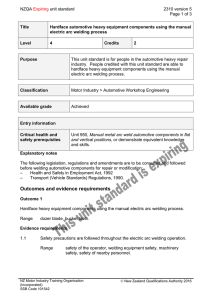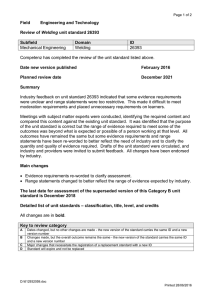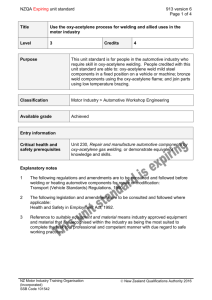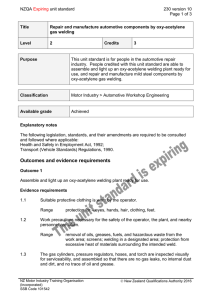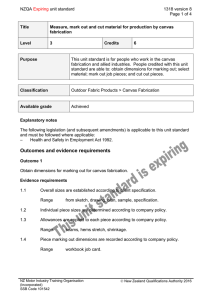NZQA unit standard 1322 version 8
advertisement
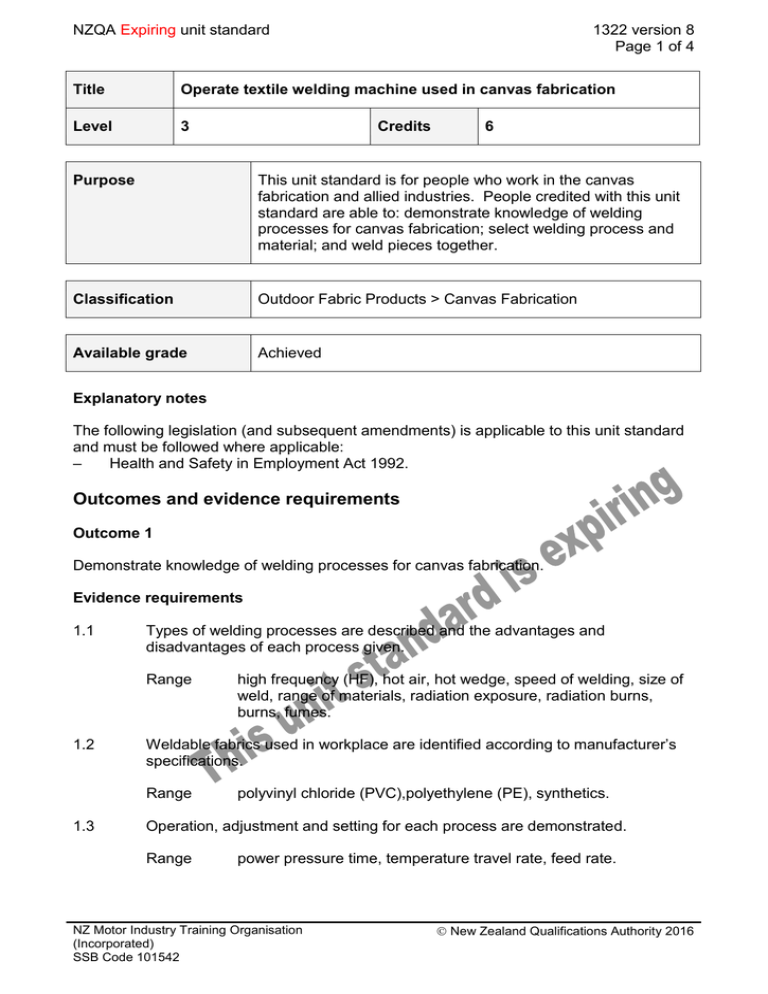
NZQA Expiring unit standard 1322 version 8 Page 1 of 4 Title Operate textile welding machine used in canvas fabrication Level 3 Credits 6 Purpose This unit standard is for people who work in the canvas fabrication and allied industries. People credited with this unit standard are able to: demonstrate knowledge of welding processes for canvas fabrication; select welding process and material; and weld pieces together. Classification Outdoor Fabric Products > Canvas Fabrication Available grade Achieved Explanatory notes The following legislation (and subsequent amendments) is applicable to this unit standard and must be followed where applicable: – Health and Safety in Employment Act 1992. Outcomes and evidence requirements Outcome 1 Demonstrate knowledge of welding processes for canvas fabrication. Evidence requirements 1.1 Types of welding processes are described and the advantages and disadvantages of each process given. Range 1.2 Weldable fabrics used in workplace are identified according to manufacturer’s specifications. Range 1.3 high frequency (HF), hot air, hot wedge, speed of welding, size of weld, range of materials, radiation exposure, radiation burns, burns, fumes. polyvinyl chloride (PVC),polyethylene (PE), synthetics. Operation, adjustment and setting for each process are demonstrated. Range power pressure time, temperature travel rate, feed rate. NZ Motor Industry Training Organisation (Incorporated) SSB Code 101542 New Zealand Qualifications Authority 2016 NZQA Expiring unit standard 1.4 Characteristics of good welding are demonstrated according to company and manufacturer’s requirements. Range 1.5 1322 version 8 Page 2 of 4 shear, peel, penetration, even and flat, melt line, waterproof. Barrier material use and characteristics are described for HF welding according to company and manufacturer’s specifications. Outcome 2 Select welding process and material for canvas fabrication. Evidence requirements 2.1 Material is selected to client and/or workplace requirement. 2.2 Welding process is selected to suit material and job requirement according to company policy. Range 2.3 Electrodes and welding aids are selected to suit the job according to manufacturer’s specifications and company policy. Range 2.4 bars, formes, nozzles, fabric guides, barrier material. HF energy transmission straps are inspected for safety and suitability according to company policy. Range 2.5 width of weld, number and type of weld, HF, hot air, hot wedge. material, size, correctly attached. Safe working practices are carried out throughout the task. Range personal safety; safety of other people; workshop safety; tool, equipment, and machine safety. Outcome 3 Weld pieces together. Evidence requirements 3.1 Material to be welded is prepared and pieces produced according to company policy. Range 3.2 sheet to sheet, clicking press, vertical knife, circular knife, cut by hand. Welding machine is set initially to produce a weld according to manufacturer’ specifications. NZ Motor Industry Training Organisation (Incorporated) SSB Code 101542 New Zealand Qualifications Authority 2016 NZQA Expiring unit standard 1322 version 8 Page 3 of 4 3.3 Sample of job material is welded and adjustment made until a weld is proved in warp and weft directions according to company policy. 3.4 Job pieces are welded in the required position and checked according to company policy. Range position, flat wrinkle free, good weld, free of marks. 3.5 On completion of job welding machine is cleaned and stored according to company policy. 3.6 Safe working practices are carried out throughout the task. Range personal safety; safety of other people; workshop safety; tool, equipment, and machine safety. Replacement information This unit standard has been replaced by unit standard 23499, unit standard 23500, unit standard 23501, and unit standard 23502. This unit standard is expiring. Assessment against the standard must take place by the last date for assessment set out below. Status information and last date for assessment for superseded versions Process Version Date Last Date for Assessment Registration 1 3 August 1995 31 December 2016 Revision 2 16 September 1997 31 December 2016 Revision 3 4 November 1997 31 December 2016 Revision 4 28 May 1998 31 December 2016 Review 5 17 August 1999 31 December 2016 Review 6 26 March 2007 31 December 2016 Rollover 7 19 November 2010 31 December 2016 Rollover 8 20 November 2015 31 December 2020 Consent and Moderation Requirements (CMR) reference 0014 This CMR can be accessed at http://www.nzqa.govt.nz/framework/search/index.do. Please note Providers must be granted consent to assess against standards (accredited) by NZQA, or an inter-institutional body with delegated authority for quality assurance, before they can report credits from assessment against unit standards or deliver courses of study leading to that assessment. NZ Motor Industry Training Organisation (Incorporated) SSB Code 101542 New Zealand Qualifications Authority 2016 NZQA Expiring unit standard 1322 version 8 Page 4 of 4 Industry Training Organisations must be granted consent to assess against standards by NZQA before they can register credits from assessment against unit standards. Providers and Industry Training Organisations, which have been granted consent and which are assessing against unit standards must engage with the moderation system that applies to those standards. Consent requirements and an outline of the moderation system that applies to this standard are outlined in the Conesnt and Moderation Requirements (CMR). The CMR also includes useful information about special requirements for organisations wishing to develop education and training programmes, such as minimum qualifications for tutors and assessors, and special resource requirements. NZ Motor Industry Training Organisation (Incorporated) SSB Code 101542 New Zealand Qualifications Authority 2016
